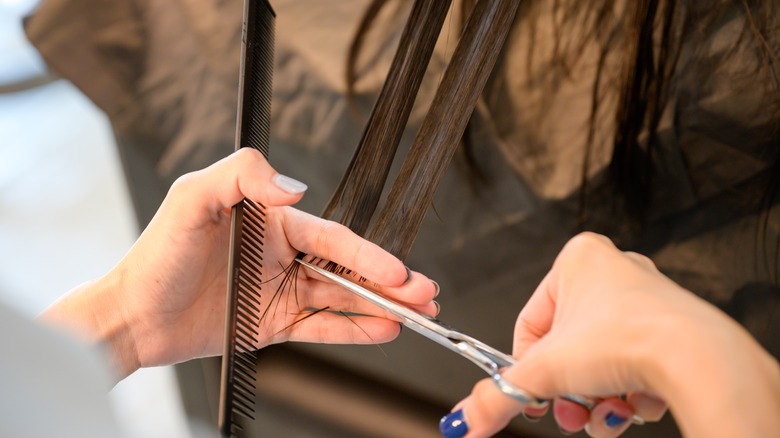Trimming Vs. Hair Dusting: Which Is Right For You?
A visit to the salon can be both exciting and nerve-racking. You're eager to maintain healthy hair. You want to visit your stylist to make sure that goal is achieved, but you can also worry about if you'd like what you come back home with. What if they cut off more than what you wanted? What if you have to sport a shorter hairdo for that party where you imagined your luscious locks being the center of attention?
The types of hair damage can be plenty, but split ends are a regular threat to healthy hair (not to mention the fact that they take away from how good your tresses can look), per Southern Living. In come two forms of getting rid of split ends that your stylist might choose depending on your preference: trimming and dusting. While you may have heard about trimming before, the same probably cannot be said for the term "hair dusting."
What exactly is dusting and how is it different from trimming? Which form of getting rid of frayed ends is right for you?
Trimming shortens your hair more than dusting does
With hair dusting, what you would be losing is about a quarter of an inch of your tresses; there is also another form of dusting called "surface dusting" where no amount of length is lost. L'Oréal professional artist Jill Engelsen told Hair that "surface dusting is when you blow dry the hair straight and rest the hair flat on the open palm of your hand and cut parallel on the surface to remove any small hairs that stick out and are damaged." This method of taking care of frayed ends pays attention to more than just the tips.
"Think of it in terms of removing fuzz from clothes," L.A.-based hairstylist Sal Salcedo told Refinery29. While the technique has been used for a long time, the time-consuming nature of this method makes it a rare offering in salons.
Trimming, on the other hand, results in you losing about 2 inches of your locks, according to Greatist. With trimming, what you're doing is maintaining the shape of your hairstyle, per Prose. Just like with dusting, the purpose of trimming is to get rid of split ends and maintain overall hair health, as noted by We Heart This.
Which method is right for you?
If you want to maintain length, trimming might not be the best option for you, although this grooming technique is great when it comes to adding life to your locks (via Greatist). You may be opting for trimming thinking that it makes your hair grow faster, but there is no truth to this claim, per Naturally Curly. If you get rid of split ends, however, you'll spare your hair some damage.
Dusting is a good choice for those looking to keep their hair length, maintain overall hair health, and get rid of the split ends wherever they've shown up along the hair shaft, according to Prose. It is also something you can ask your stylist to do for you while you're at the salon getting something else done. Dusting might also be a good option for those who use heating tools on their tresses often, so the damage from such styling is kept to a minimum, adds Southern Living. If you have straight hair that's thick, it pretty much means you've got the perfect hair type for dusting. Moderately wavy tresses could benefit too, although curly hair types may not.
When it comes to how expensive one is over the other, dusting might be on the lower end of the spectrum. But you may have to find a stylist who knows what they're doing in order to reap the benefits of this technique.

